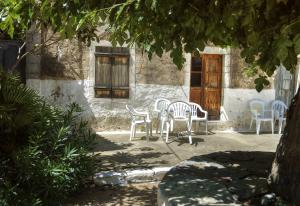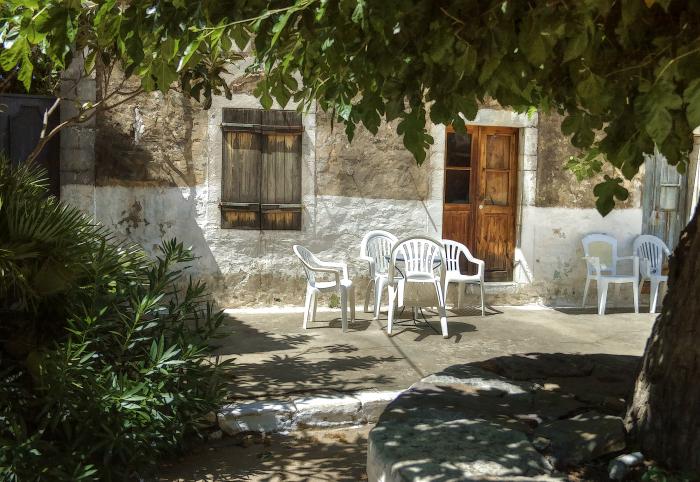Category: General Photography
Post Type:
Mixed Media
Photography
Mixed Media: Medium | Cropped - tone mapped - poster lines minor
Pays
one point
and 2 member cents.





© Copyright 2024. avmurray All rights reserved.
avmurray has granted FanStory.com, its affiliates and its syndicates non-exclusive rights to display this work.
Posted: August 30, 2015
      |
Greece
The Village of Thalames
by avmurray
Interested in this? Contact The Artist
Lights and Shadows - Photography (b) Contest Entry
You can own this. Offers accepted. Information
Thalames has a number of reasons for stopping and has more of a village feel to it with a proper platea with plane trees, the olive oil factory, run by Heinz Neth, producing the excellent "Morea" Oil.
The platea has a fine arched well or washing place cum water-trough (which sticks out into the road, I know because I have inadvertently driven over it once whilst temporarily distracted from watching the road) and another well washing place which has an inscription dated to the 1770s. Thalames was an ancient site called Thalamai (or Thalamae) which according to Pausanius housed an temple to the oracle to Ino Pasiphai (the moon) which reportedly had 3 bronze statues. The village is also referred to its older name, Koutiphari.
The area was also famed for its marble quarries. The British School at Athens looked at the site as part of their Lakonia Survey in the early years of the 20th century. Marcus Tod (1878-1974) later an eminent Oxford ancient scholar, then deputy director and Librarian of the BSA, surveyed the site in November 1904 and digging, under the supervision of Guy Dickins, began in the March of 1905 and was concentrated around the spring, which was described as central to the oracle - there are no signs of this archaeological work - unsurprisingly - a century later.
Dickins published his findings in the Annual of the British School at Athens in the 1905 volume (XI). He pointed out that the two wells in Svina (another older name for the area around the two wells and small shaded plataea on today's main road) rarely dry up even in the hottest summer and that, apart from two insignificant springs in Langada there are no more springs for many miles to the south of Thalames. He was also curious about a legendary treasure which had been reported in the journal Pandora back in the 1860s, which was reportedly buried in the olive groves belonging to a certain widow Strongyleas a bit to the north of the second well. The story still had local credence at the time Dickins' visit, though he had to report that little of significance was actually found in the field. It is clear that the site has been occupied since early times, and ancient bits and bobs turn up in Byzantine and modern buildings.
by avmurray Interested in this? Contact The Artist
The platea has a fine arched well or washing place cum water-trough (which sticks out into the road, I know because I have inadvertently driven over it once whilst temporarily distracted from watching the road) and another well washing place which has an inscription dated to the 1770s. Thalames was an ancient site called Thalamai (or Thalamae) which according to Pausanius housed an temple to the oracle to Ino Pasiphai (the moon) which reportedly had 3 bronze statues. The village is also referred to its older name, Koutiphari.
The area was also famed for its marble quarries. The British School at Athens looked at the site as part of their Lakonia Survey in the early years of the 20th century. Marcus Tod (1878-1974) later an eminent Oxford ancient scholar, then deputy director and Librarian of the BSA, surveyed the site in November 1904 and digging, under the supervision of Guy Dickins, began in the March of 1905 and was concentrated around the spring, which was described as central to the oracle - there are no signs of this archaeological work - unsurprisingly - a century later.
Dickins published his findings in the Annual of the British School at Athens in the 1905 volume (XI). He pointed out that the two wells in Svina (another older name for the area around the two wells and small shaded plataea on today's main road) rarely dry up even in the hottest summer and that, apart from two insignificant springs in Langada there are no more springs for many miles to the south of Thalames. He was also curious about a legendary treasure which had been reported in the journal Pandora back in the 1860s, which was reportedly buried in the olive groves belonging to a certain widow Strongyleas a bit to the north of the second well. The story still had local credence at the time Dickins' visit, though he had to report that little of significance was actually found in the field. It is clear that the site has been occupied since early times, and ancient bits and bobs turn up in Byzantine and modern buildings.
Mixed Media: Medium | Cropped - tone mapped - poster lines minor


The Village of Thalames
by avmurray

You need to login or register to write reviews. It's quick! We only ask four questions to new members.
© Copyright 2024. avmurray All rights reserved.
avmurray has granted FanStory.com, its affiliates and its syndicates non-exclusive rights to display this work.

